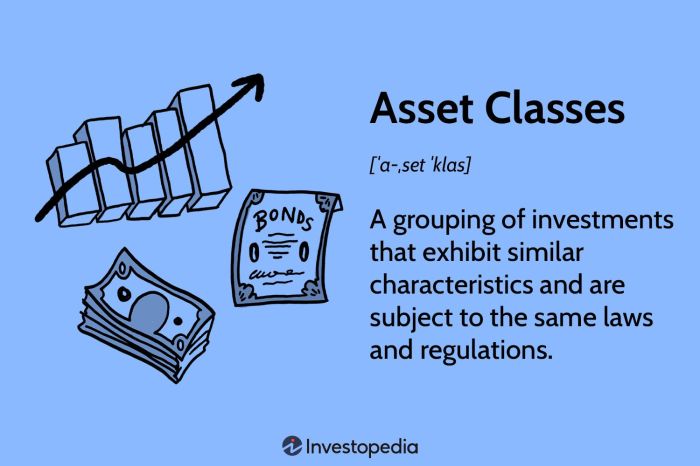Get ready to dive into the world of asset classes with a fresh perspective that will leave you enlightened and ready to conquer the investment game. Brace yourself for an exciting journey filled with knowledge bombs and valuable insights that will change the way you view your investment portfolio.
In this guide, we’ll break down the complexities of asset classes, from traditional to alternative, and show you how to navigate the diverse landscape of stocks, bonds, real estate, and commodities.
What are Asset Classes?
Asset classes are groups of investments that have similar characteristics and behave similarly in the market. They are used by investors to diversify their portfolios and manage risk. Examples of asset classes include stocks, bonds, real estate, commodities, and cash equivalents.
Asset classes are important in investment portfolios because they allow investors to spread their risk across different types of assets. By investing in a variety of asset classes, investors can reduce the impact of market fluctuations on their overall portfolio value.
Traditional vs. Alternative Asset Classes
Traditional asset classes are the most common types of investments, such as stocks, bonds, and cash equivalents. These assets are typically more liquid and easier to value compared to alternative asset classes.
- Stocks: Represent ownership in a company and offer potential for capital appreciation.
- Bonds: Represent debt issued by corporations or governments and provide regular interest payments.
- Real Estate: Includes properties like residential, commercial, and industrial real estate.
- Commodities: Include physical goods like gold, oil, and agricultural products.
- Cash Equivalents: Investments with high liquidity and low risk, such as money market funds and Treasury bills.
Alternative asset classes, on the other hand, include investments like private equity, hedge funds, real assets, and cryptocurrencies. These assets often have lower correlation to traditional asset classes, providing diversification benefits to investors.
Types of Asset Classes
Investors have a wide variety of asset classes to choose from when building their investment portfolios. Each asset class comes with its own unique characteristics, risk profiles, and behaviors in different market conditions.
Stocks
Stocks represent ownership in a company, giving investors the opportunity to participate in the company’s growth and profits. They are considered one of the riskiest asset classes but also offer the potential for high returns. Stocks tend to perform well in a growing economy but can be volatile during market downturns. Examples include shares of companies like Apple, Amazon, and Microsoft.
Bonds
Bonds are debt securities issued by governments or corporations to raise capital. They are generally considered less risky than stocks but offer lower returns. Bonds are known for their income-generating potential through regular interest payments. In times of economic uncertainty, bonds are often seen as a safer investment. Examples include U.S. Treasury bonds, corporate bonds, and municipal bonds.
Real Estate
Real estate involves investing in physical properties such as residential homes, commercial buildings, and land. Real estate is known for its potential to generate rental income and appreciate in value over time. It is considered a relatively stable asset class with moderate risk. Real estate investments can be influenced by factors like location, market trends, and interest rates.
Commodities
Commodities are raw materials or primary agricultural products that are traded on exchanges. They include assets like gold, oil, wheat, and coffee. Commodities are known for their diversification benefits and potential to hedge against inflation. Their prices are influenced by supply and demand dynamics, geopolitical events, and global economic conditions. Examples include gold as a hedge against inflation and oil as a commodity sensitive to geopolitical tensions.
Understanding Risk and Returns
When it comes to investing in different asset classes, it’s crucial to understand the relationship between risk and return. Generally, the higher the potential return of an asset class, the higher the risk involved. On the other hand, lower-risk investments typically offer lower potential returns. Let’s dive deeper into how risk and return play out in various asset classes.
Risk-Return Profiles of Different Asset Classes
- Stocks: Stocks are considered high-risk, high-reward investments. They offer the potential for significant returns but also come with a higher level of volatility and risk. It’s essential to diversify your stock portfolio to manage risk effectively.
- Bonds: Bonds are generally considered lower-risk investments compared to stocks. They provide a more predictable stream of income through interest payments and have a lower risk of capital loss. However, the returns from bonds are typically lower than those from stocks.
- Real Estate: Real estate investments fall somewhere between stocks and bonds regarding risk and return. They offer the potential for capital appreciation and rental income but also come with risks like market fluctuations and property vacancies.
- Commodities: Investing in commodities like gold, oil, or agricultural products can provide diversification benefits to a portfolio. Commodities often have a low correlation with traditional asset classes, making them a valuable addition to manage risk.
Strategies for Managing Risk and Maximizing Returns
- Diversification: Spreading your investments across different asset classes can help reduce risk. By not putting all your eggs in one basket, you can minimize the impact of a single asset’s underperformance on your overall portfolio.
- Asset Allocation: Determine the right mix of asset classes based on your risk tolerance and investment goals. Balancing high-risk, high-return investments with lower-risk assets can help you achieve a more stable portfolio over time.
- Regular Monitoring: Stay updated on market trends, economic indicators, and changes in asset prices. Adjust your investment strategy as needed to capitalize on opportunities or mitigate potential risks in different asset classes.
Diversification and Asset Allocation

Diversification is a risk management technique that involves spreading investments across various asset classes to reduce overall risk and volatility in a portfolio. Asset allocation, on the other hand, refers to the strategic distribution of investments among different asset classes based on an individual’s investment goals, risk tolerance, and time horizon.
Importance of Diversification in Asset Allocation
Diversification is crucial in asset allocation as it helps minimize the impact of market fluctuations on a portfolio. By investing in a mix of asset classes such as stocks, bonds, real estate, and commodities, investors can reduce the risk of significant losses that may occur if they were heavily concentrated in a single asset class.
- Diversification helps in spreading risk across different types of investments, reducing the overall volatility of a portfolio.
- It can enhance potential returns by capturing gains in different sectors of the market at different times.
- By diversifying, investors can also align their portfolios with their risk tolerance and investment objectives.
Examples of Asset Allocation Strategies
Asset allocation strategies can vary depending on an individual’s investment goals. Here are some common examples:
- Conservative Approach: Investors looking for capital preservation and income may opt for a conservative strategy with a higher allocation to fixed income securities such as bonds and cash equivalents.
- Moderate Approach: A moderate strategy may involve a balanced mix of stocks and bonds to achieve a blend of growth and income while managing risk.
- Aggressive Approach: Those seeking higher returns and willing to take on more risk may choose an aggressive strategy with a larger allocation to equities and alternative investments.






